ECS Z77H2-A2X (v1.0) Review: “Golden” LGA 1155 Mainboard from the “Black” Series

This mainboard is a flagship product from ECS. It boasts extended functionality and a number of unique peculiarities. Our today’s review will discuss all the advantages or this product alongside with the challenges that the users may face if they decide on this “golden” board.
If you decided to find an Elitegroup mainboard that would best fit your needs, this might be a pretty challenging task. It is fairly easy to visit one of the company web-sites and get to a page with all mainboard models listed, but how do you find the right one? The choice is even trickier because of the complicated model naming approach used for ECS mainboards. Yes, you can single out certain rules, for example, the first three positions in the model name indicate that Z77H2-A4 is based on an Intel Z77 Express chipset, while H77H2-M3 – on Intel H77 Express chipset. Moreover, you may notice that the first letter in the second part of the model name usually stands for the form-factor: “A” – for ATX, “M” – for microATX, “I” – for mini-ITX. Sometimes, you may see a letter “D”, which stands for the pretty rare DTX form-factor. Unfortunately, all the other symbols in the model name are hard to decipher. Moreover, the logical naming approach we have just proposed falls completely apart once you realize that there is no way to tell the chipset for the X77H2-A3 mainboard, or the form-factor for the H61H-G11.
However, we have known for a long time that besides the regular mainboards Elitegroup also offers the so called “Black” series with advanced feature list. That may seem like a good way out if we limit our choice options to the products in this series, but it turns out that the “Black” series is pretty versatile, too. Of course, a lot depends on your choice of chipset, but out of nine boards on Intel Z77 Express, six mainboards, i.e. 2/3 of all, belong to the “Black” series.
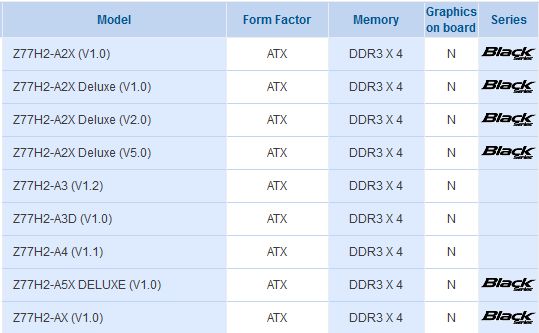
The models that immediately catch our eye are the ones with the word “Deluxe” in their model name. it is quite possible that one of these boards will be the best fit for your specific needs, but the model comparison system implemented on the company web-site won’t be able to help you distinguish between Z77H2-A2X Deluxe version 1.0, 2.0 or 5.0. On top of that I am sure you will be surprised to find out that the mainboard with a pretty unremarkable name, Z77H2-A2X, has more features and functions than the “Deluxe” models with the same name. It may seem strange, but there is logic to it. The boards from the “Black Deluxe” sub-series have the word “Deluxe” in their model name, while the boards from the “Black Extreme” sub-series do not have the word “Extreme” in their model name. And that is a real pity, because it could have helped a lot with the decision-making. It would make even more sense to single out the flagship models by using the “Golden Board” term, for example, because it would make it clear that these are unique products that stand out among the rest. However, today we are going to introduce to you ECS Z77H2-A2X (v.1.0). Despite the modest model name, this is one of the top mainboards in the “Black Extreme” series and one of the Golden boards, which you will see shortly.
Packaging and Accessories
Even if you are far and unable to read “Golden board” printed on the packaging or recognize the “Black Extreme” series logo, you will unmistakably see that it is a “golden” mainboards, because it comes in a golden box.
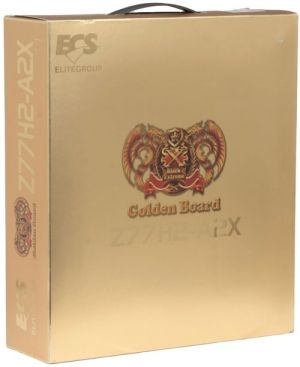
The exterior of the front and back of the mainboard box is identical. In fact, it is the first time we ever see a box, which front as well as the back side are both attached with Velcro and can be opened. Just like with most other top mainboards out there, the front side of the box can be flipped open to reveal the mainboard inside through a large clear window. If you flip open the back of the box, you will see some info about this mainboard model with illustrations. Other than that, everything is quite common. There is a sturdy box made of thick cardboard beneath the “golden” top box. The board is protected by an anti-static bag and a cardboard casing, and all the bundled accessories are arranged in a smaller box under the mainboard:
- Six SATA cables with metal connector locks and only with straight connectors;
- A module with two additional USB 3.0 ports for the front or back panel of the system case;
- A set of slot covers for the video outs and USB ports;
- I/O Shield for the back panel;
- User manual;
- Colorful poster with brief assembly instructions in multiple languages;
- Manual on LucidLogix Virtu MVP Technology;
- DVD disk with software and drivers.
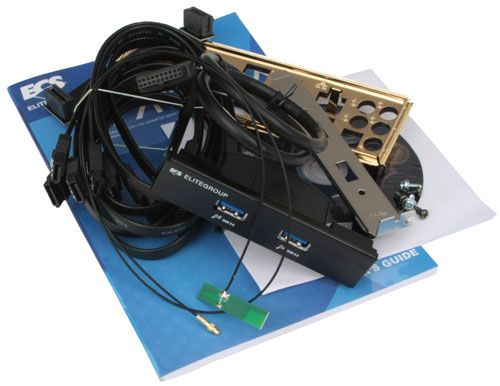
We have already seen many mainboards that come with additional brackets with USB 3.0 ports for the back of the system case. Other models sometimes come with a module that would bring these ports to the front of the system case. However, Elitegroup came up with the most universal and user-friendly solution. The bracket bundled with the board is originally designed to allow adding two more USB 3.0 ports to the front of the system case, but it also comes with an additional bracket and a set of screws that will let you move these ports to the back of the system case, too. Only ASRock mainboards come with a similar universal component, which also has a chassis for a 2-inch drive built into it, but the solution from Elitegroup boasts longer connecting cable. Another peculiarity of Elitegroup mainboards is a set of plastic caps for the Video Outs and USB ports, which will protect them from damage and dust. They are not in the photo above, but as you can see there is an antenna on that photo, which must have got into the box with our board by accident.
PCB Design and Functionality
The real golden mainboard can’t just have a golden box. ECS Z77H2-A2X (v1.0) has “golden” heatsinks, capacitors, core chokes, processor socket and even an entire back panel. They used “Gold 4ever” principle in the design of their mainboard:
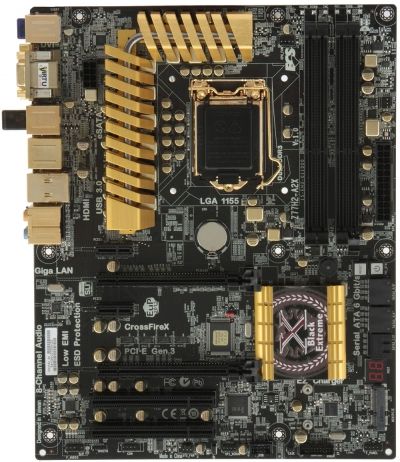
Of course, everyone knows that golden mainboards use this color primarily for aesthetical purposes, but it also has practical value. All “Black” series mainboards, not only the “golden” ones, have 15 micron gold plating on connector contacts, which ensures excellent contact, high reliability and extended life of the connectors.
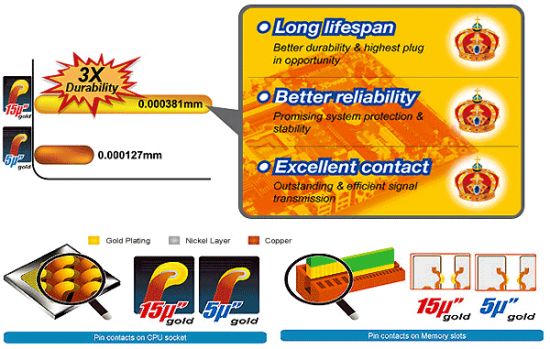
In our previous review we talked about MSI Z77 MPOWER mainboard. The unique thing about this mainboard is that it undergoes a serious 24-hour stress test in an overclocked system using Prime95 utility before hitting the stores. However, the unique peculiarity of all contemporary Elitegroup mainboards from the “Black” series is the “ECS Nonstop Technology” – a 72-hour stress test at 50°C temperature. This technology also implies the use of high-quality solid state capacitors and anti-static protection. So, if we consider only the extend of the pre-sale testing, we will be able to conclude that in this respect all Elitegroup mainboards from the “Black” series are three times better than the only mainboard from Micro-Star.
But, let’s get back to ECS Z77H2-A2X (v1.0). The golden heatsinks on the processor voltage regulator circuitry components are remarkable not only for their color, but also for their reliable screw-on retention and a connecting heatpipe. The logo on the chipset heatsink performs not only decorative functions, but is also capable of changing color under higher temperatures, thus indicating possible overheating. However, Intel Z77 Express chipset doesn’t heat up too much, so we have not seen any heatsink color changes during our test session.
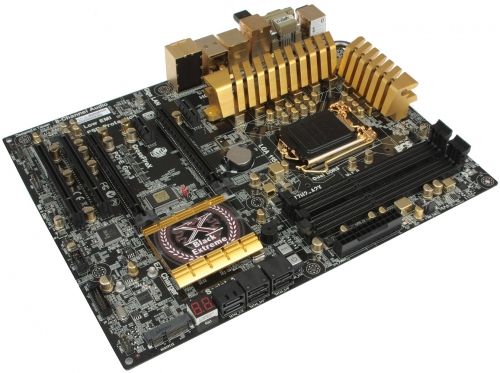
There are two PCI Express 3.0/2.0 x16 graphics card slots, which can share the bandwidth and allow building ATI CrossFire or Nvidia SLI multi-card configurations. There are also two PCI Express 2.0 x1 and two PCI slots. It is a real pity that Elitegroup mainboards do not use color-coding principles for their connectors, because it could make it a lot easier to distinguish between different SATA ports. Two additional SATA 6 Gbps ports are implemented via ASMedia ASM1061 controller. Another two SATA 6 Gbps ports are supported by the Intel Z77 Express chipset, but out of four SATA 3 Gbps ports provided by the chipset, we see only two. One of the “missing” ports powers the universal Mini SATA or Mini PCI Express slot, while the second one is laid out as an eSATA port on the mainboard’s back panel.

The complete list of ports and connectors on the back of ECS Z77H2-A2X (v1.0) looks as follows:
- Bluetooth v2.1+EDR (Atheros AR3011) and Wi-Fi IEEE 802.11 b/g/n (Atheros AR9271) wireless modules;
- Four USB 2.0 ports, another two ports are laid out as an onboard pin-connector;
- D-Sub, DVI-D and HDMI video outs;
- eSATA 3 Gbps port;
- Four USB 3.0 ports (blue connectors) provided by the Intel Z77 Express chipset. ASMedia ASM1042 controller provides an additional pin-connector for two more USB 3.0 ports;
- A local network port (network adapter is built on Gigabit Realtek RTL8111E controller;
- An optical S/PDIF and five analogue audio-jacks provided by eight-channel Realtek ALC892 codec.
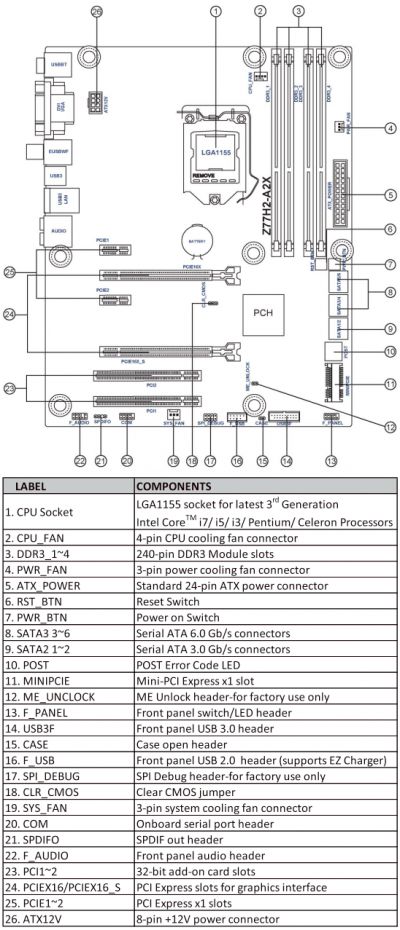
The components layout chart shows the Power On and Reset buttons, and a POST-code indicator. There are control points for manual voltage monitoring a little above the memory DIMM slots, although you won’t see them on the layout chart. Unfortunately, there are only three fan connectors onboard. This should be more than enough for a small microATX platform, but not for a top mainboard in the family. Moreover, the internal USB 3.0 pin-connector is not in the best place. It is at the very bottom of the PCB, which makes it easier to bring these additional ports to the back, but not to the front panel. A longer cable of the universal USB 3.0 port module that is bundled with the ECS Z77H2-A2X (v1.0) mainboard partially makes up for this inconvenience.
We summed up all the major technical specifications of the ECS Z77H2-A2X (v1.0) mainboard in the following table for your convenience:
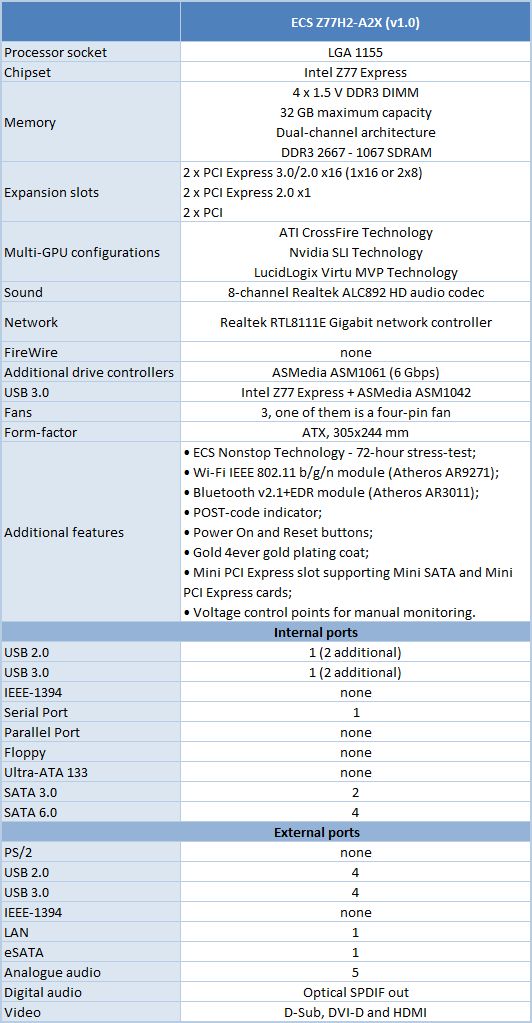
BIOS Functionality
It has been a while since we checked out the BIOS of Elitegroup mainboards, namely, in our ECS P67H2-A and P67H2-A2 mainboard review. Back then it didn’t make the best impression. Even if we disregard some of the specific issues we uncovered, its overall internal organization was pretty confusing, its interface wasn’t very appealing and it obviously lacked user-friendliness. Since then the BIOS has undergone significant modifications and has changed for the best for the most part. Now when you enter the BIOS you see a simplified “EZ Mode”, where you can select the interface language, load default settings and arrange the order of boot-up devices. Besides that, you can see the brief system info at the bottom of the screen: model name, BIOS version, date and time, processor model name and system memory size.
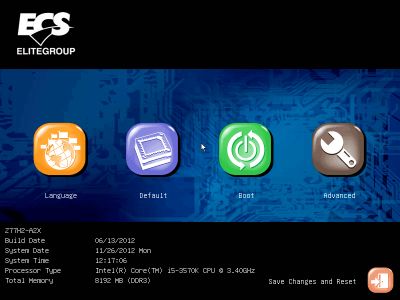
If the EZ Mode also allowed changing date and time, it would be sufficient to load the basic settings and start working immediately, although I have to admit its functionality is pretty modest. So, in any case you will have to switch to “Advanced Mode” where you will immediately get into the “Main” section, which will let you change not only the interface language, but also the date and time.
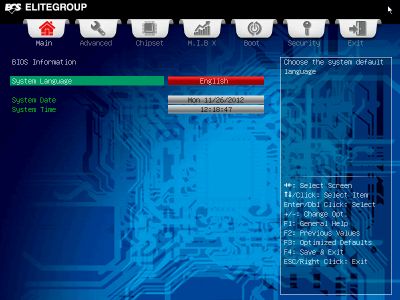
The new BIOS looks very similar to the old one, though the background color has become a little lighter and the mouse pointer is now white and doesn’t get lost against the dark background. The BIOS sections at the top now have graphics icons, the selected parameters become more visible, because they are highlighted green. These are all the positive changes that guarantee better user experience, as we have mentioned above.
The list of sub-sections in the “Advanced” section gives us a great idea of its functionality. It is fairly strange that of all unique technologies of the Intel Z77 Express chipset we only see “Intel Rapid Start”, and “Intel Smart Connect” is missing altogether. They may have forgotten to add it, because their web-site does mention it.
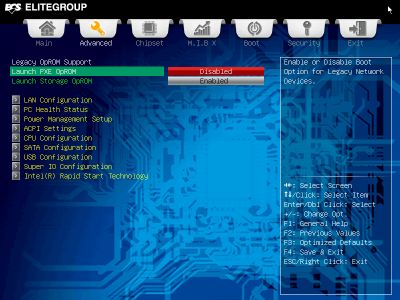
Now let’s take a glance at the “PC Health Status” sub-section, which serves purely informational purposes and reports the fan rotation speeds and some voltages.
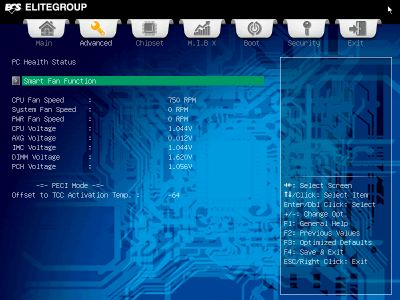
To adjust the rotation speeds of the connected fans you need to switch to “Smart Fan Function” page. The board is capable of reporting the rotation speeds of all three fans that can be connected to it, but to rotation speed of only two fans can actually be adjusted. Moreover, there is only one onboard connector that can handle the rotation speed adjustment of a three-pin system fan, this will not work for the processor fan. You can select one of the preset rotation speed modes – Normal, Quiet and Silent, or set the desired speed manually.
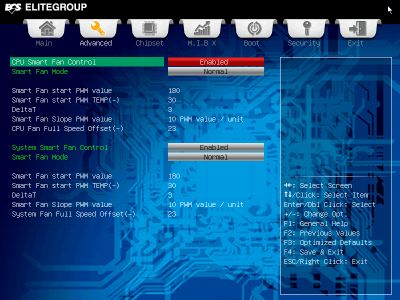
Another sub-section in the “Advanced” section worth checking out is called “CPU Configuration”, where we get basic information about our processor and can configure some of the processor technologies.
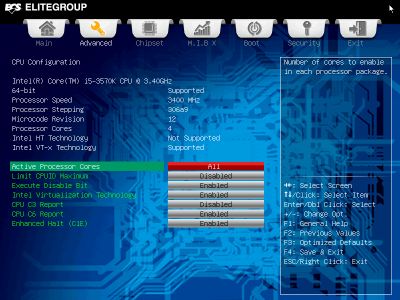
The next section on the list is “Chipset”. The sub-sections here allow setting the initialization order for the graphics adapters, configuring the integrated graphics core and audio system.
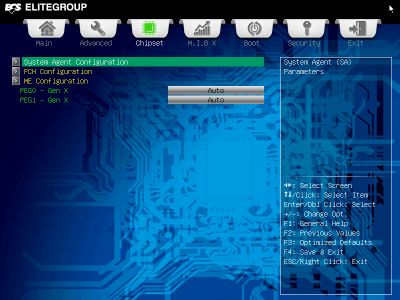
The section with most of the overclocking-related settings is called “M.I.B.X.” (MB Intelligent BIOS X). There are two sub-sections that will allow configuring processor and memory parameters, while the majority of settings in the main window will deal raising the operational voltages. It is pretty convenient that we see the current voltages at the bottom of the window, but it is a real pity that we no longer can lower the voltage settings. For example, you can notice that the default memory voltage is 1.62 V. this is a safe, but nevertheless excessively high voltage for our specific memory modules, but we have no way of lowering it.
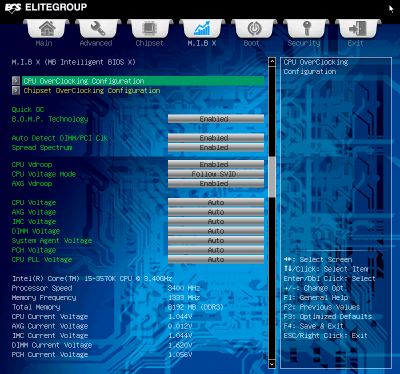
“CPU Overclocking Configuration” page will let you change the base clock, processor clock frequency multiplier and some other important parameters, which are highlighted green. The settings in white are unavailable to us, although this isn’t the case in the BIOS of other manufacturers’ mainboards.
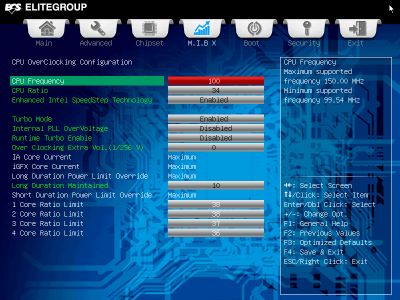
All parameters in the “Chipset Overclocking Configuration” page dealing with the system memory are set automatically and cannot be changed. The board supports “XMP” profiles, but even in this case we cannot modify any parameters manually.
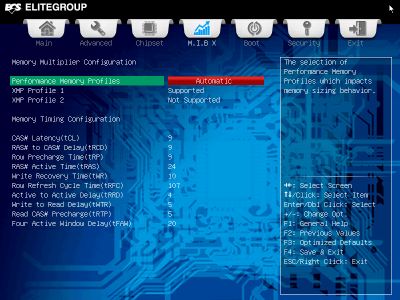
Even if we need to change only one setting, all of them must be set manually, which is not very convenient. Moreover, the bard doesn’t tell you the resulting memory frequency once all your changes have been applied, so you will have to calculate it on your own. However, this is not a big deal, since the “Memory Clock Multiplier” parameter doesn’t work. There is only one setting for it – 1.33, while in reality it equals 1.0. As a result, while the majority of other mainboards in the systems with Ivy Bridge processors offer us a wide variety of frequencies to choose from ranging between 800 and 3200 MHz, ECS Z77H2-A2X (v1.0) supports only seven memory frequency settings in the interval from 1067 to 2667 MHz.
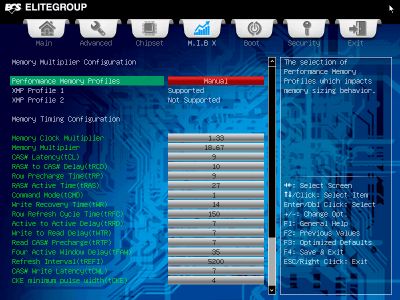
The “Boot” section offers to configure the system behavior during startup.
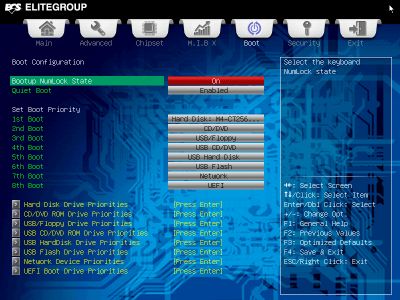
You set user and administrator passwords in the “Security” section.
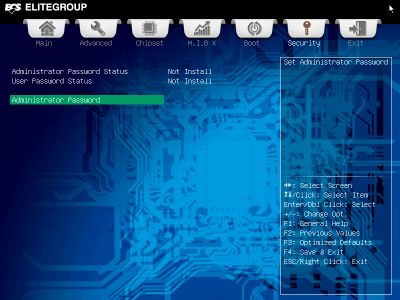
“Exit” section will help switch back to EZ Mode, save the configuration changes or abort them, or load the default settings.
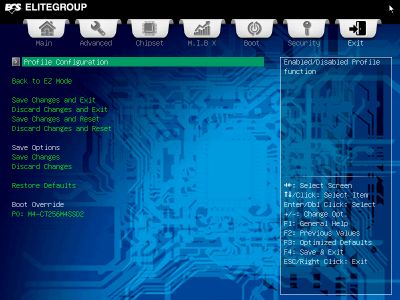
You can save up to eight BIOS settings profiles in the “Profile Configuration” page. Each will be given a unique descriptive name. However, external storage media are not supported here.
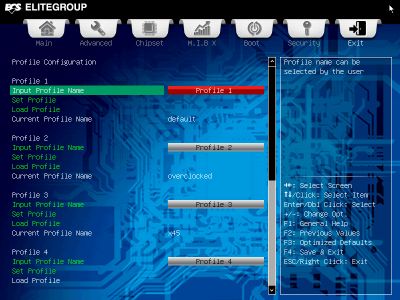
In conclusion I would like to repeat once again that BIOS of Elitegroup mainboards has improved dramatically. However, there is still room for further positive changes bringing it closer to the best BIOS implementations out there from other developers.
Testbed Configuration
We carried out our tests on a testbed that included the following components:
- ECS Z77H2-A2X (v1.0) mainboard (LGA 1155, Intel Z77 Express, BIOS version 13.06.12);
- Intel Core i5-3570K CPU (3.6-3.8 GHz, 4 cores, Ivy Bridge rev.E1, 22nm, 77 W, 1.05 V, LGA 1155);
- 2 x 4 GB DDR3 SDRAM Corsair Vengeance CMZ16GX3M4X1866C9R (1866 MHz, 9-10-9-27 timings, 1.5 V voltage);
- Gigabyte GV-R797OC-3GD graphics card (AMD Radeon HD 7970, Tahiti, 28 nm, 1000/5500 MHz, 384-bit GDDR5 3072 MB);
- Crucial m4 SSD (CT256M4SSD2, 256 GB, SATA 6 Gbps);
- Scythe Mugen 3 Revision B (SCMG-3100) CPU cooler;
- ARCTIC MX-2 thermal interface;
- Enermax NAXN ENM850EWT PSU;
- Open testbed built using Antec Skeleton system case.
We used Microsoft Windows 7 Ultimate SP1 64 bit (Microsoft Windows, Version 6.1, Build 7601: Service Pack 1) operating system, Intel Chipset Software Installation Utility version 9.3.0.1020, AMD Catalyst 12.4 graphics card driver.
Operational and Overclocking Specifics
We had no problems of any kind during system assembly on ECS Z77H2-A2X (v1.0) mainboard. However, before starting our test session, we usually update the BIOS with the latest version available at the time of tests. However, this is where we had to face quite a disappointment: there were no newer BIOS versions available. This isn’t a big deal, and it happens all the time, if the board comes with a pretty new BIOS version already, but unfortunately, there was only one single BIOS version available dating back to the late March of 2012 and launched in early April 2012, right before the release of the new seventh series chipsets, including Intel Z77 Express. It looked like no one cared about this mainboard once it had been launched. Once we checked out the mainboard and the BIOS and noticed that it improved a lot compared with the versions we saw on older mainboards, but still had a few things that could be addressed, we requested an updated version. We got a BIOS version from 13.06.12, which we used for all benchmarks and screenshots in this review. Unfortunately, the only thing different was the release date, while all uncovered minor issues remained intact.
The testbed on ECS Z77H2-A2X (v1.0) powered on fine and started working normally, although it was somewhat strange that by default only the additional ASMedia ASM1061 controller was set to “AHCI Mode”, while all drives connected to the chipset ports were still working in “IDE Mode”. It is not really a problem, you can easily change this setting, but it is unclear why they would do it this way. The board displays a modest start-up image with the useful reminders about the hot keys. There are not options that would allow you to disable this image, so there is no way to see the startup info during boot-up.
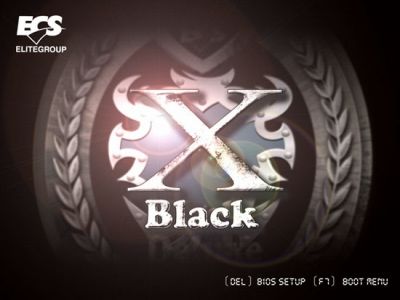
With the default settings the board had all system components work in their proper nominal modes, except for the higher memory voltage, which we already discussed above. All power-saving technologies worked fine, too, right from the start. You encounter some challenges only when you attempt to modify some settings or make adjustments. For example, the automatic overclocking mode didn’t kick in after we used the “Quick OC” parameter in the BIOS. The voltage increased, but the processor clock frequency multiplier remained unchanged. It could, actually, be for the best, because looks like the proposed overclocking method could only work well with Sandy Bridge processors, but not with Ivy Bridge ones, because the core voltage was set 0.2 V higher, while the clock frequency multiplier was supposed to hit 45x. The good thing is that this automatic overclocking system does use XMP profile for the memory frequency. In fact, only memory actually got overclocked in the end. Note that in this case the board used the correct memory voltage of 1.5 V, which was recorded in the XMP profile. We have already mentioned that the board sets higher memory voltage by default, and there is no way for the user to lower it manually. So, it ends up being not quite logical: the memory working at 1333 MHz uses increased to 1.62 V voltage setting, while at overclocked 1867 MHz the voltage drops to 1.5 V.
During manual overclocking when the processor clock frequency multiplier does get adjusted, the board turns off all power-saving technologies. Therefore, if you pursue smart and energy-efficient overclocking, do not forget to turn them back on manually. Remember, they are not in the “M.I.B.X.” section among the majority of overclocking-related options, but in the “Advanced” section. Unlike other manufacturers’ mainboards, the processor Load-Line Calibration cannot be adjusted: it can only be turned on or off. You can’t set the desired Vdroop value. Despite pretty limited feature set we managed to overclock our test processor to 4.5 GHz, which is a good result under the circumstances, but the maximum of 4.6 GHz remained unattained.
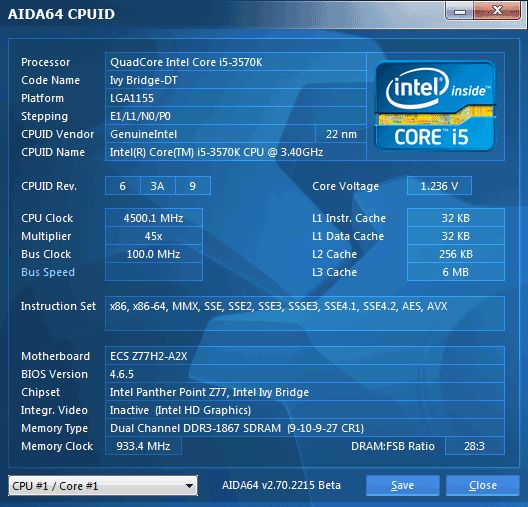
You may have noticed that the processor Vcore is extremely high, but it is mostly because the board seems to be reporting higher values than the actual ones, as the CPU temperature remained within normal range even under very heavy operational load. Another thing worth pointing out: the memory frequency was increased with the help of an XMP profile, while the board set 9-10-9-27-1T timings on its own. In fact, the profile timings read 9-10-9-27-2T and we normally manually correct them. As we have already said before, ECS Z77H2-A2X (v1.0) mainboard doesn’t allow adjusting any settings if you select the XMP profile, so these not quite correct memory timings were actually to our advantage. This is a very lucky coincidence, but the overall flexibility of the BIOS settings still leave more to be desired.
Now I would only like to remind you that we always overclock mainboards in such a way that they could be used for a prolonged period of time in this mode. We do not try to make our life easier by disabling any of the mainboard features, such as onboard controllers, for example. We also try to keep the CPU’s power-saving technologies up and running normally to the best of our ability. And this time all power-saving technologies remained up and running even during overclocking lowering the CPU voltage and frequency multiplier in idle mode.
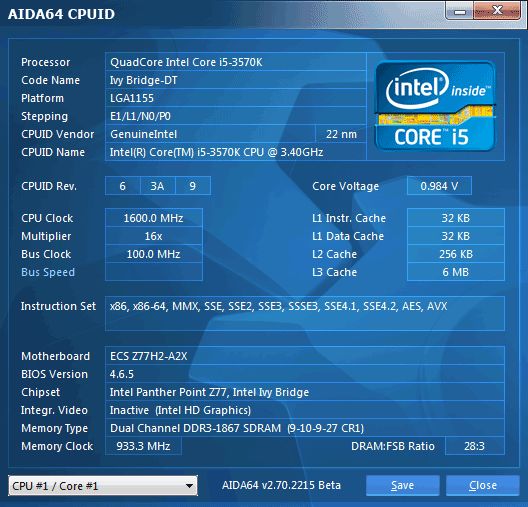
Performance Comparison
As usual, we are going to compare the mainboards speeds in two different modes: in nominal mode and during CPU and memory overclocking. The first mode is interesting because it shows how well the mainboards work with their default settings. It is a known fact that most users do not fine-tune their systems, they simply choose the optimal BIOS settings and do nothing else. That is why we run a round of tests almost without interfering in any way with the default mainboard settings. For comparison purposes we also included the results of the previously reviewed mainboards:
- ASRock Fatal1ty Z77 Professional
- ASRock Z77 Extreme4 and ASRock Z77 Extreme6
- ASRock Z77 Extreme9
- ASRock Z77 OC Formula
- Asus Maximus V Formula
- Asus P8Z77-V Deluxe
- Asus P8Z77-V LX
- Asus P8Z77-V Premium
- Asus Sabertooth Z77
- Gigabyte G1.Sniper 3
- Gigabyte GA-Z77X-UD3H and GA-Z77X-UD5H-WB WIFI
- Gigabyte GA-Z77X-UP4 TH and Gigabyte GA-Z77X-UP5 TH
- Gigabyte GA-Z77X-UP7
- Intel DZ77BH-55K
- Intel DZ77GA-70K and Intel DZ77RE-75K
- MSI Z77 MPOWER
- MSI Z77A-GD65.
The results on the diagrams are sorted out in descending order. The results of ECS Z77H2-A2X (v1.0) mainboard are highlighted with a darker color for your convenience.
Nominal Mode
We used Cinebench 11.5. All tests were run five times and the average result of the five runs was taken for the performance charts.
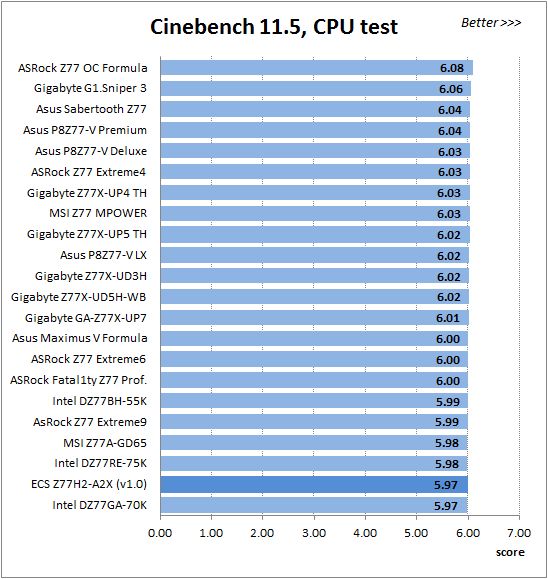
We have been using Fritz Chess Benchmark utility for a long time already and it proved very illustrative. It generated repeated results, the performance in it is scales perfectly depending on the number of involved computational threads.
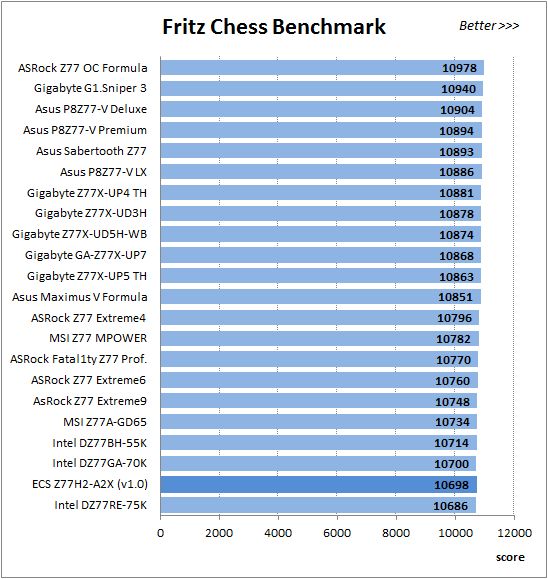
A small video in x264 HD Benchmark 4.0 is encoded in two passes and then the entire process is repeated four times. The average results of the second pass are displayed on the following diagram:
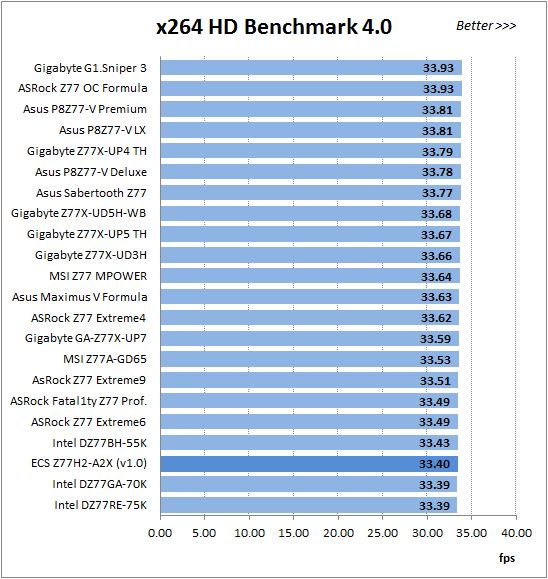
We measured the performance in Adobe Photoshop using our own benchmark made from Retouch Artists Photoshop Speed Test that has been creatively modified. It includes typical editing of four 10-megapixel images from a digital photo camera.
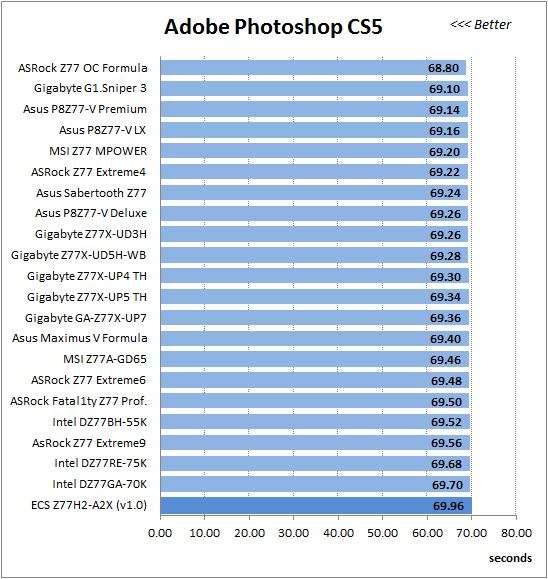
In the archiving test a 1 GB file is compressed using LZMA2 algorithms, while other compression settings remain at defaults.
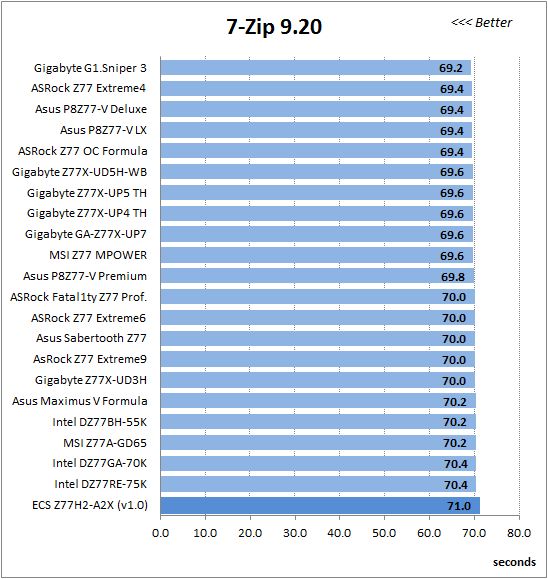
Like in the data compression test, the faster 16 million of Pi digits are calculated, the better. This is the only benchmark where the number of processor cores doesn’t really matter, because it creates single-threaded load.
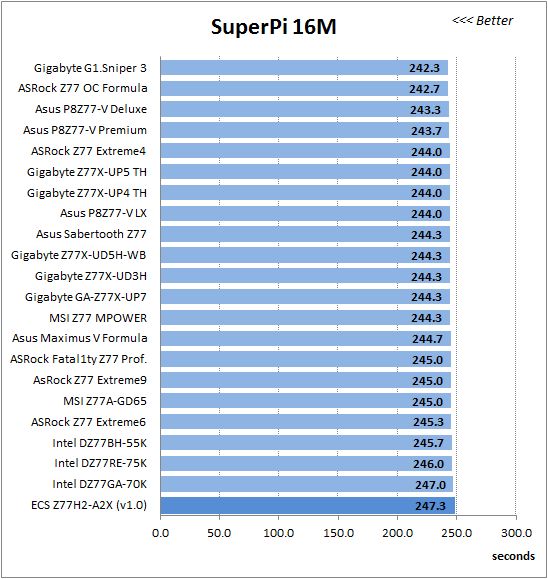
Since we do not overclock graphics in our mainboard reviews, the next diagram shows only CPU tests from the 3DMark11 – Physics Score. This score is obtained in a special physics test that emulates the behavior of a complex gaming system working with numerous objects:
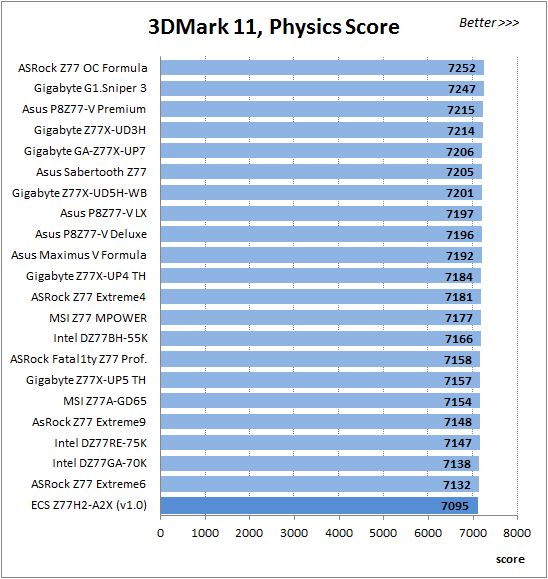
We use FC2 Benchmark Tool to go over Ranch Small map ten times in 1920×1080 resolution with high image quality settings in DirectX 10.
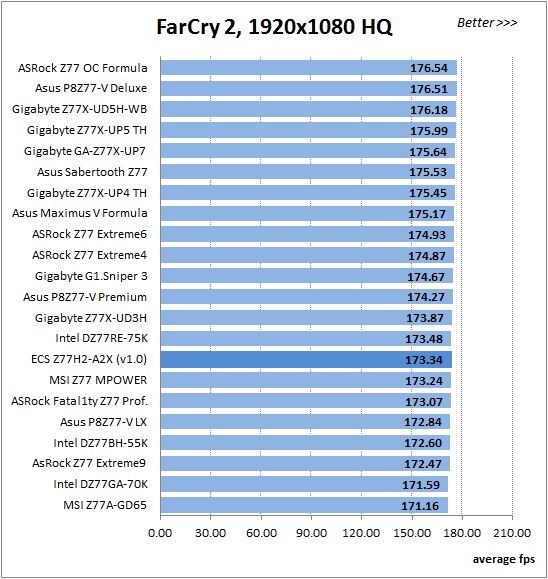
Resident Evil 5 game also has a built-in performance test. Its peculiarity is that it can really take advantage of multi-core processor architecture. The tests were run in DirectX 10 in 1920×1080 resolution with high image quality settings. The average of five test runs was taken for further analysis:
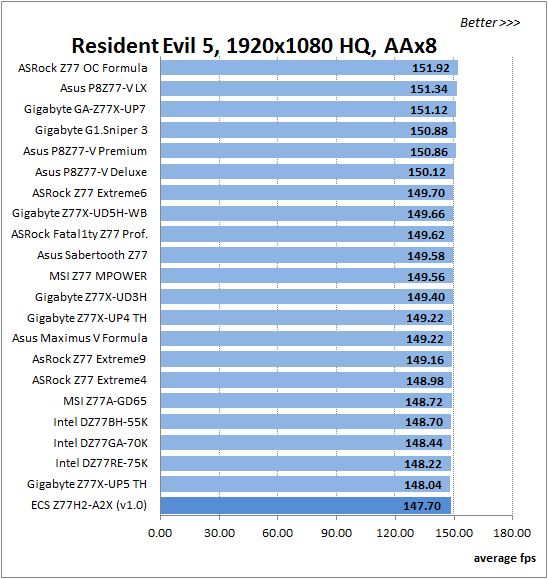
Batman: Arkham City game also reacts eagerly to any changes in the CPU clock frequency, but it uses DirectX 11. We ran game’s integrated benchmark five times with high image quality settings and then take the average of the five runs for the diagrams.
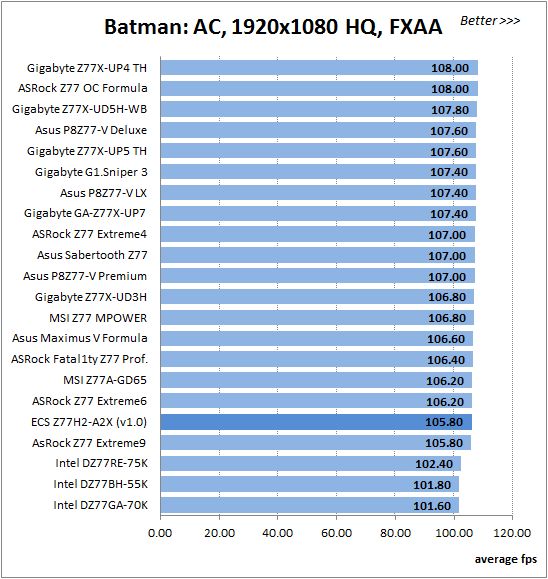
We see a great illustration of the known fact that related mainboards working in identical testing conditions demonstrate about the same performance. This is also true for ECS Z77H2-A2X (v1.0), although it is often the slowest of comparable models. The difference is minimal, but it exists.
Overclocked Mode
During processor and memory overclocking, different mainboards accomplished different results, which we summed up in the following table for your convenience:
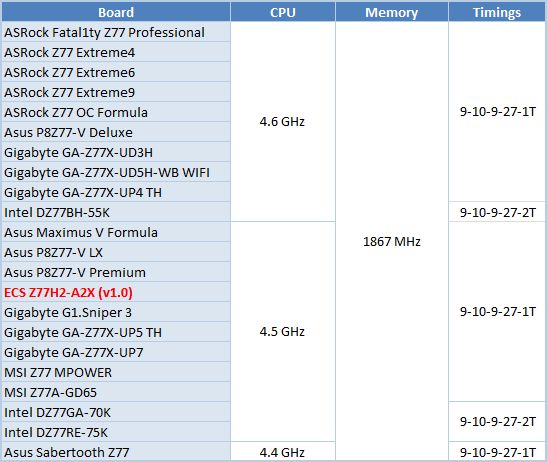
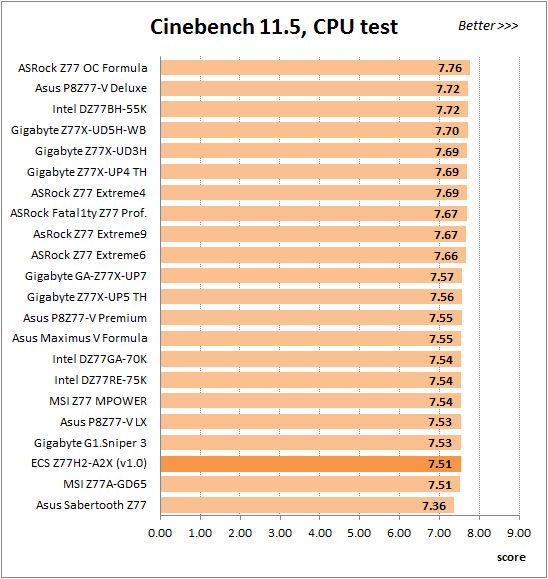
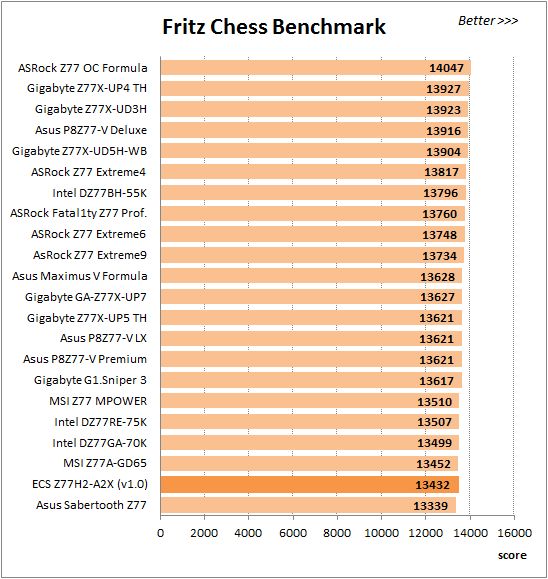
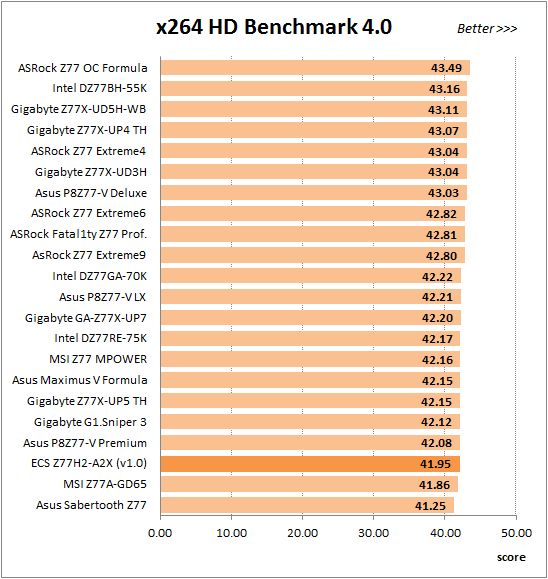
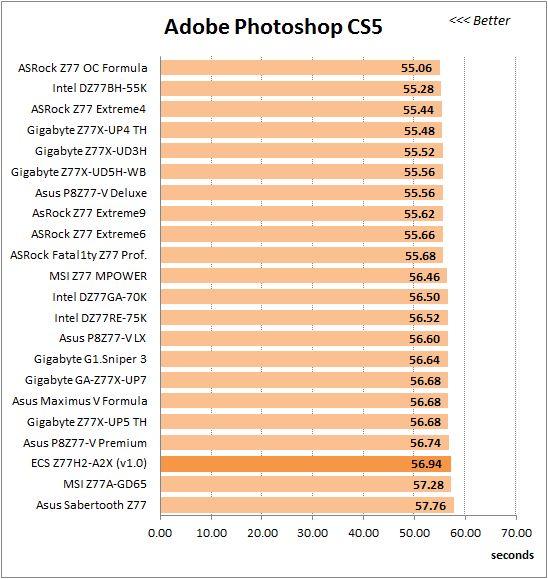
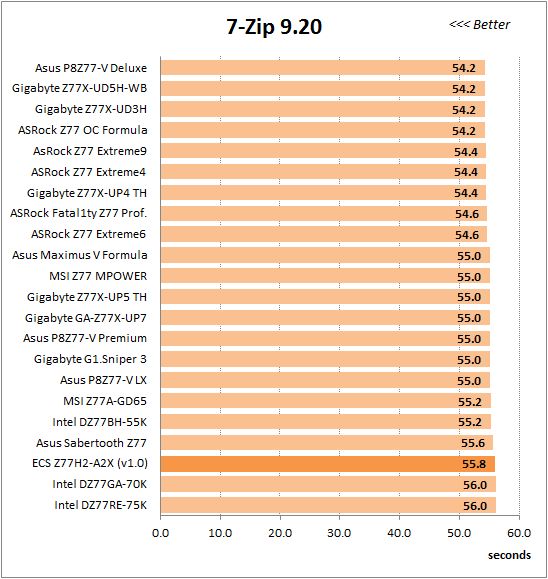
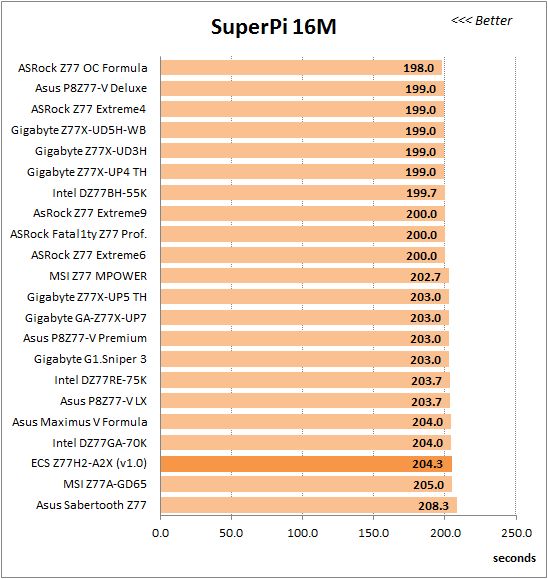
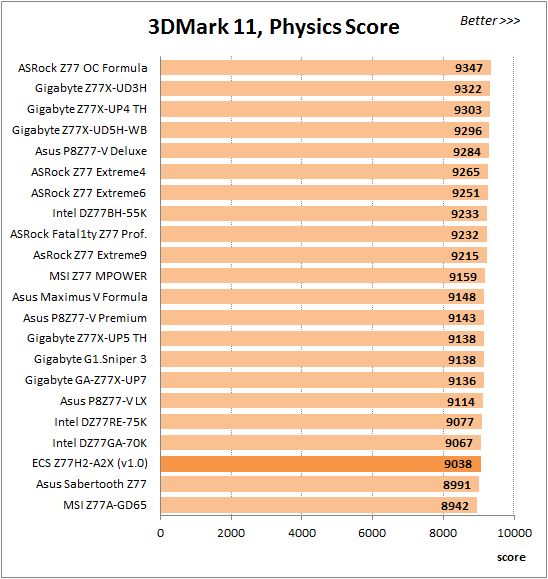
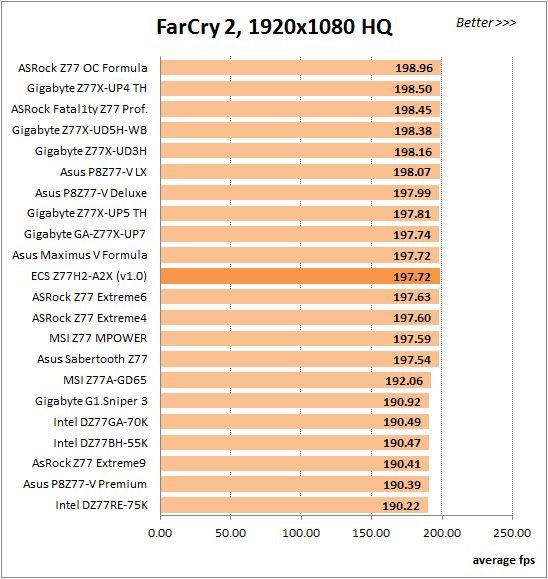
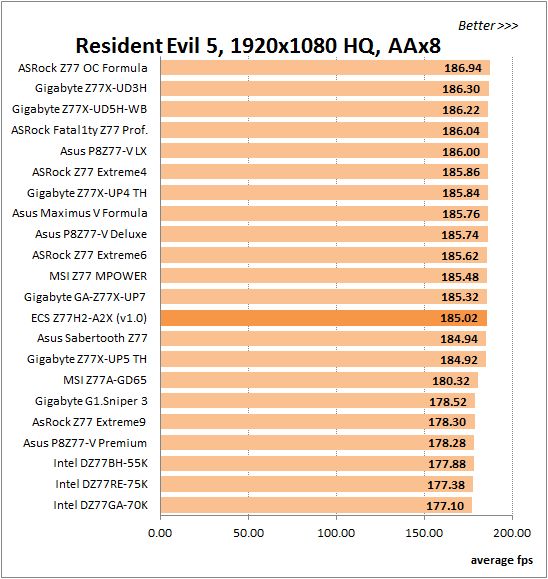
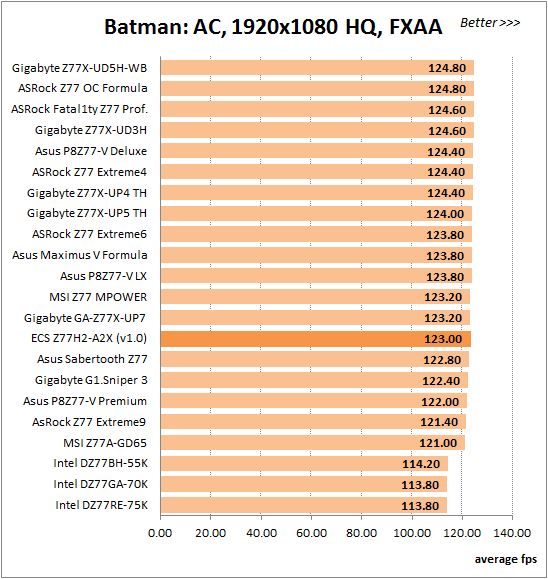
Power Consumption
We performed our power consumption measurements using an Extech Power Analyzer 380803. This device is connected before the PSU and measures the power draw of the entire system (without the monitor), including the power loss that occurs in the PSU itself. In the idle mode we start the system up and wait until it stops accessing the hard disk. Then we use LinX to load the CPU. Because of compatibility issues we uncovered in Gigabyte GA-Z77X-UP4 TH and Gigabyte GA-Z77X-UP5 TH mainboards with our original CoolerMaster RealPower M850 power supply unit, we had to replace it with Enermax NAXN ENM850EW. Both these PSUs have very similar technical characteristics, but Enermax NAXN ENM850EWT is about 1-3 W more energy-efficient than the Cooler Master unit. In order to be able to use the previously obtained results, we decided to make up for this efficiency difference by adding 2 W to all new power readings, so that we could still compare their results against the power consumption of all previously tested products.
For a more illustrative picture there are graphs that show how the computer power consumption grows up depending on the number of active execution threads in LinX (both at the default and overclocked system settings). The results of ECS Z77H2-A2X (v1.0) are marked with darker color for your convenience.
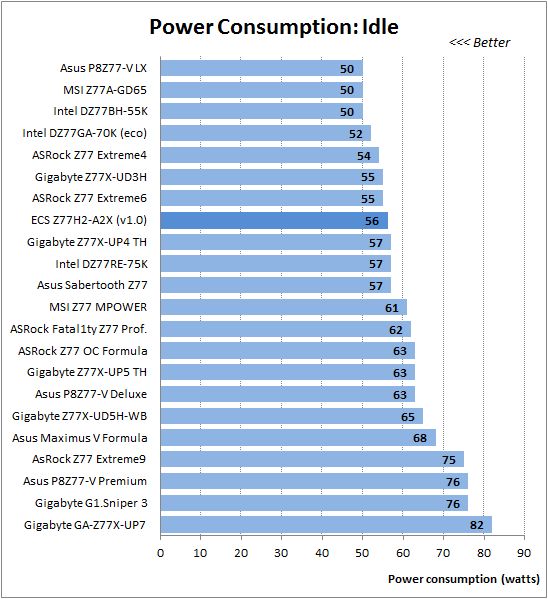
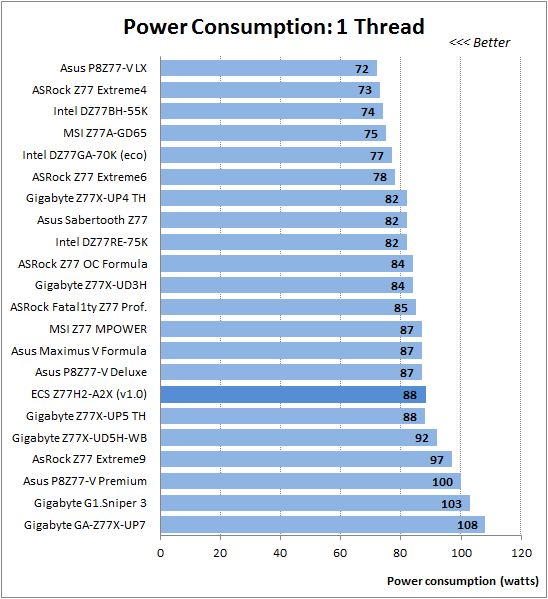
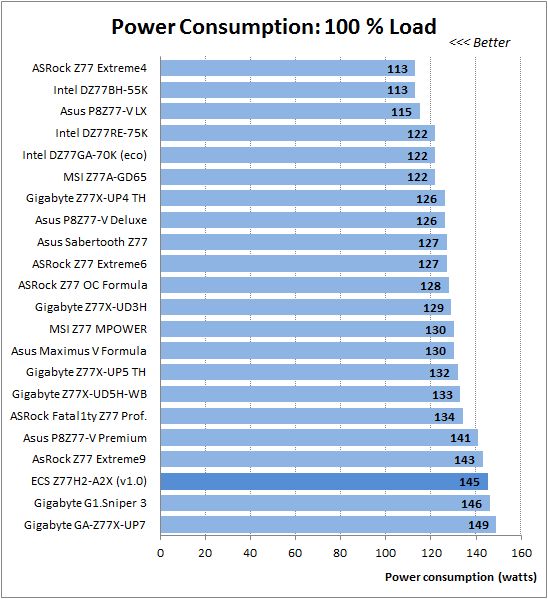
We have already mentioned that all power-saving technologies are enabled and working properly on ECS Z77H2-A2X (v1.0) right from the beginning, therefore, its power consumption in idle mode is very low. However, once the CPU starts working hard everything changes. Even under low single-threaded load the system power consumption increases above average, while maximum CPU utilization places the board among those models that have an additional PLX PEX 8747 hub onboard. This hub increases the overall mainboards power consumption, but offers extended functionality in terms of supported graphics configurations in return. However, ECS Z77H2-A2X (v1.0) doesn’t have any additional hubs, yet its power consumption is unjustifiably high.
In overclocked mode the board’s power consumption in idle mode and under minimal operational loads is average, but once the CPU utilization rises to the maximum the power consumption goes beyond average level. It is important to remember that the board managed to overclock the processor only to 4.5 GHz, and had it hit the 4.6 GHz maximum, its power consumption would have easily become the highest of all tested mainboards. During our preliminary overclocking tests it grew as high as 200 W, which is something we have never seen before on any of the tested boards.
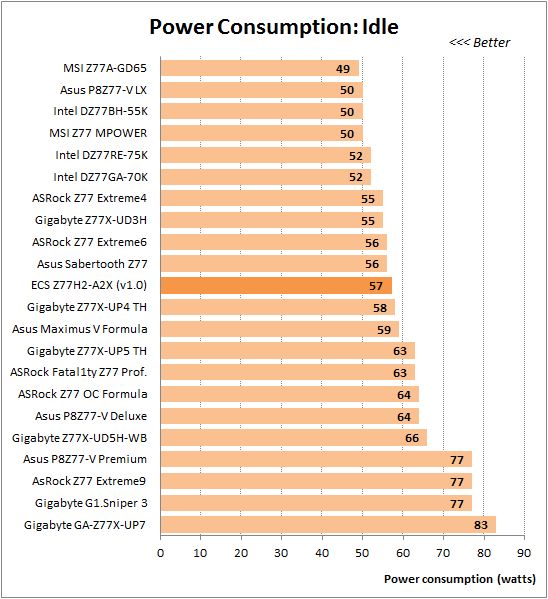
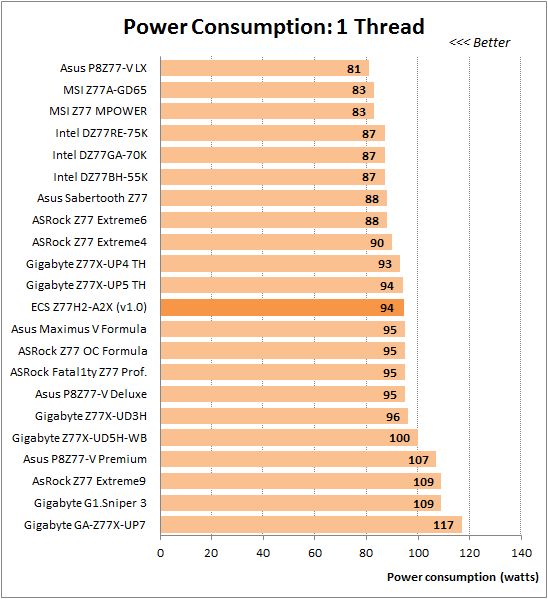
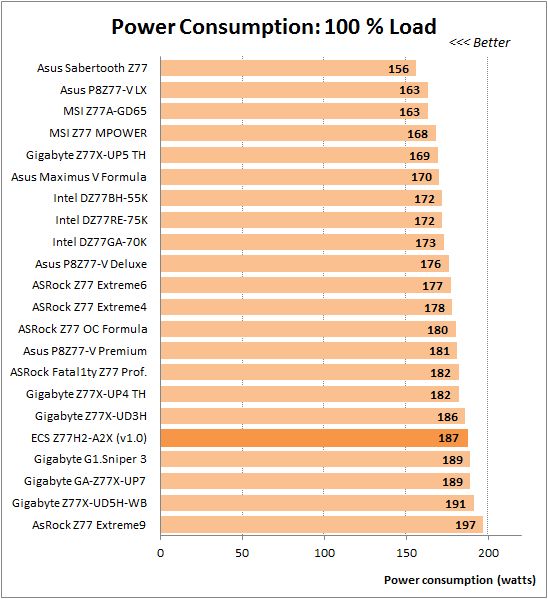
Conclusion
I have to admit that we have mixed feelings about ECS Z77H2-A2X (v1.0) mainboard. We loved the packaging, could say a lot of good things about the bundled accessories, but have a few comments about the design and functionality. We wish its performance were somewhat higher and power consumption somewhat lower. Although the performance difference is not dramatic at all compared with other mainboards, it is undeniable. As for the power consumption, it is on good level in idle mode, but is excessively high under heavy operational loads. It seems that the processor voltage regulator circuitry may have been designed not in the most optimal way and that is something you cannot fix that easily. The board works fine with the default settings, but overclocking and meticulous system fine-tuning pose certain challenges. Of course, the BIOS version we worked with has been improved a lot compared with the previous versions. It has become more user-friendly, but there are still quite a few things that could be changed for the better, and could use additional flexibility.
We often hope that some of the concerns we express in our reviews could be eventually addressed in the new BIOS versions, but it looks like it isn’t the case for ECS Z77H2-A2X (v1.0). Some of the Elitegroup mainboard models received BIOS updates in October of 2012, but the last beta-BIOS for ECS Z77H2-A2X (v1.0) is the one from mid-summer, to our great regret. Hopefully they will do something about it and won’t leave the board to the mercy of fate, because when you buy a board you need to know that the manufacturer stands behind the product and will provide you the support you need.